
ZF Friedrichshafen AG, also known as ZF Group, originally Zahnradfabrik Friedrichshafen, and commonly abbreviated to ZF, is a German technology manufacturing company that supplies systems for passenger cars, commercial vehicles and industrial technology. It is headquartered in Friedrichshafen, in the south-west German state of Baden-Württemberg. Specializing in engineering, it is primarily known for its design, research and development, and manufacturing activities in the automotive industry and is one of the largest automotive suppliers in the world. Its products include driveline and chassis technology for cars and commercial vehicles, along with specialized plant equipment such as construction equipment. It is also involved in the rail, marine, defense and aviation industries, as well as general industrial applications. ZF has 162 production locations in 31 countries with approximately 168,700 (2023) employees.

The Enfield 8000 is a two-seater battery-electric city car, introduced in 1973 and developed in the United Kingdom by Isle of Wight company Enfield Automotive, owned by Greek millionaire Giannis Goulandris. The car was designed by a group of Greek and British engineers headed by Constantine Adraktas with John Ackroyd as project designer, who later went on to the Thrust 2 project. The prototypes and initial production were built at the Somerton Works in Northwood, near Cowes.

MEBEA was an important Greek vehicle manufacturer, producer of light trucks, passenger automobiles, motorcycles, motorbike engines, agricultural machinery and bicycles.

Petropoulos is today a major importer and distributor of vehicles and heavy machinery, having been, at the same time, one of the historic Greek tractor, vehicle and engine manufacturers.

STYL KAR was named after its founder, the engineer Stylianos Karakatsanis. Its entire history is representative of many Greek companies who were engaged in the construction of simple utility vehicles.

Attica was a brand name of vehicles produced by Bioplastic S.A., a company created in Moschato, Athens by Georgios Dimitriadis, a figure in Greek automotive history.

DIM Motor Company, a Greek automobile maker, was created by Georgios Dimitriadis as a successor to his earlier company, Bioplastic S.A., which had produced the Attica automobile. The DIM represented one more effort by Mr. Dimitriadis to design and develop a modern car entirely by his company's own means. A 400cc, air-cooled, 2-cylinder, 30-hp engine was also developed in-house to power the vehicle, but due to delays in the engine development, the car was introduced with a 600cc engine and other mechanical parts of the Fiat 126 model. A 650cc Fiat engine was also used, in an improved version. The car was finally introduced at the Geneva Motor Show in 1977, and for this reason received more publicity than most Greek vehicles, appearing in many international publications. All development work had been made in a factory intended for its production in Acharnes, while the company was advertised in the Greek press; plans were also made for more versions, including a sports coupe. However, the costs involved and the car's poor prospects in the Greek market resulted in termination of production after only about ten had been produced. The whole project was abandoned in 1982, having been Georgios Dimitriadis' last venture in the automotive industry.
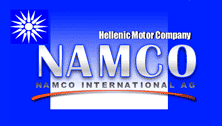
NAMCO is a Greek vehicle manufacturer. It was founded in 1972 by the Kontogouris brothers.
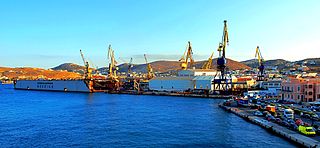
Neorion is one of the oldest Greek heavy industries, located in Ermoupolis, on the Greek island of Syros. Today, it is one of the few remaining major industrial corporations in what used to be the industrial and commercial center of Greece, before being eclipsed by Piraeus in the late 19th century.
Agricola was a Greek maker of 4x4 multi-purpose trucks and other farm machinery based in Thessaloniki. The Agricola 25 GT 4x4 truck was a fairly advanced design introduced in 1975, with enhanced all-terrain capabilities, a metal cab and Mercedes-Benz 180D Diesel engine. It was a typical Greek multi-purpose truck with a payload of 1,650 kg (3,638 lb) and a maximum speed 80 km/h (50 mph). The cab was designed by Georgios Michael, designer of other Greek vehicles including the Neorion Chicago and the MAVA-Renault Farma. The vehicle was produced until 1984.

AutoDiana was a Greek truck manufacturer based in Thessaloniki, in business between 1975 and 1984. Its main product was the 'Unicar' truck. This robust vehicle had a payload of 1500 kg and used a Mercedes-Benz Diesel engine and Dodge axles. Its fate, along with similar Greek multi-purpose trucks, such as Petropoulos Unitrak, the Agricola, the Motoemil Autofarma, the Balkania Autotractor, the Namco Agricar, was sealed when a change of Greek law in 1984 modified taxes and duties for such farm vehicles. Production was terminated the same year ending a career of reasonable sales among customers in the Greek countryside.
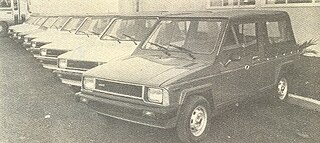
Automeccanica was a Greek automobile producing company. Founded in 1979, it was one of the companies that produced the "passenger-utility" type of vehicle popular in Greece at the time for tax categorization reasons. Its creators were former executives of Autokinitoviomihania Ellados a company founded in 1975 to also produce vehicles of this type – it assembled Italian Fissore models based on Fiat products, as well as other Fiat models and variants. Automeccanica followed a different path, building the Zebra model, a passenger-utility car based on the Daihatsu Charade, as well as assembling the Charade itself. In 1985, when the law favoring the Zebra-type vehicles changed, Automeccanica stopped its production and started licence production of the Soviet Lada Niva model, while it developed its own cabrio-version of the car. In 1988 it acquired its former "father" company, Autokinitoviomihania Ellados and the latter's factory in Thiva. Automeccanica went out of the car-construction business in 1995.
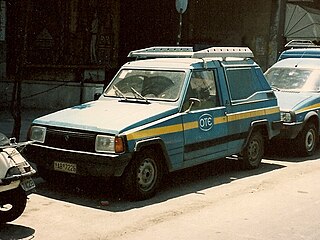
The Farma, accordingly bearing the Renault logo, was produced in a variety of versions, including "passenger" and "van" types. It had a 4-cylinder 845 cc 34 hp (25 kW) engine and could reach a top speed of about 110 km/h (68 mph).

C.AR was a Greek automotive company, founded in 1970. Originally it was called ARCO, both names being formed from the name of its founder, Constantinos Argyriadis, an engineer and architect. With its headquarters in Thessaloniki and a well-equipped factory in Kilkis it concentrated on design and development of automobiles and related technologies, including composite materials, novel suspension and brake designs, electric vehicles, etc. None of its vehicles, though, entered production and thus this company represents an odd case of personal vision and persistence with catastrophic financial results.
Thessaloniki Science Center and Technology Museum (NOESIS) is a science and technology located in Thermi at the outskirts of Thessaloniki, Central Macedonia, Greece. The museum is actively engaged in the protection of the Greek technological heritage. In addition to technological exhibits on its premises, it houses various types of facilities, such as a planetarium, an amphitheatre, a simulation room, and a wide-screen cinema for the projection of educational programs.
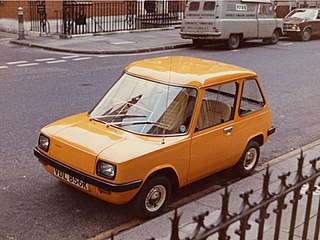
Enfield Automotive was an electric car manufacturer founded in the United Kingdom in the 1960s. Under the ownership of Greek millionaire Giannis Goulandris, production was moved to the Greek isle of Syros during the oil crisis of 1973, although the vehicles were, according to one report, not up to the expected quality and production was moved back to the Isle of Wight while other that were part built in Syros were sent back to be assembled on the Isle of Wight. According to other reports, the cars were built on Syros and sent to Britain for installation of the batteries.
This article provides an overview of the automotive industry in countries around the world.

The Pony Super is a light utility vehicle that was produced between 1985 and 1992 by the Greek manufacturer NAMCO as a successor to the first generation Pony-Citroën model.
The automotive industry in North Korea is a branch of the national economy, with much lower production than the automotive industry in South Korea. In North Korea motor vehicle production is focused on military and industrial goals, including construction; few private citizens own cars.
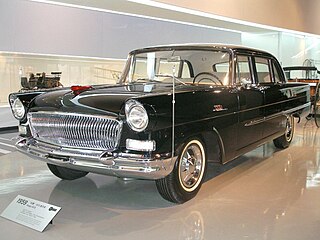
The Hongqi CA72 is an automobile produced by FAW Hongqi. It was the company's first production automobile and the first representative sedan that was constructed and built in China. Produced from 1959 until 1965, the CA72 was only available to state institutions and the leadership of the Chinese Communist Party and was regularly used in public events until the 1970s. Numerous details about technology and production are unclear.

















